Contents
Market Overview
Macro Review
Markets continue to dry out as EM technicals remain supportive. European rates remained under pressure with tapering commentary around PEPP (EUR 1.325bn facility), although hawkish comments from Philip Lane and Luis de Guindos reflect a change of previously held views. These comments followed the 3.4% rise in German HCIP inflation, which is the highest rate of change since July 2008. This in turn sent Italian BTP yields to six-week highs, which ended the week 10 bps wider as German bunds widened 8 bps. In the U.S., Non-Farm Payrolls underwhelmed just as ADP came in weak, although the response was subdued due to higher average hourly earnings. Meanwhile, more fiscal stimulus out of Japan is likely, just as PM Suga is set to step down before the next leadership contest later this month. The outperformance of Japanese stocks and the Nikkei contributed to lifting the MSCI World Index to a new all-time high. Elsewhere, OPEC+ stuck with a 400k hike as per the existing policy, while the Chinese Caixin PMI slipped into contractionary territory (49.2) for the first time since April 2020, which was followed by the non-manufacturing PMI of 47.5 (against expectations of 52.0). This was the lowest reading since February 2020. Staying with China, Evergrande’s interim results were published after a profit warning in the previous week. Bonds traded down to new lows of 24 cts on the dollar. This hardly spilt over into EM credit with little-to-no sign of any contagion. EM sovereign credit tightened 12 bps in August adding 1.2 pts to total returns as spreads are now 8 bps tighter in 2021. This leaves returns up 0.7% year-to-date. The EM corporate credit asset class tightened 14 bps through August, which is 24 bps tighter this year with returns now sitting up 2.2% so far.
EM Credit Update
EM sovereign credit ended the week up +0.6% with spreads 5 bps tighter even as U.S. Treasuries widened 2-3 bps. Outperformers on the week include Zambia, Argentina and Iraq, while Belize, Tunisia and Suriname lagged. Through August we saw $34bn in U.S. HY issuance, which is the second busiest August ever. U.S. HY spreads tightened 10 bps through August with improving macro, upbeat earnings and declining default rates, which offset the weakness since early July. The performance of EM HY was even better. Sovereign supply in August was nil, as was EM corporate HY out of the CEEMEA region but Asian HY corporates issued $4bn and LATAM issued $300m (Gran Colombia Gold).
The Week Ahead
The key fixture next week rests with the ECB after recent tapering commentary. Meanwhile there are risks that the RBA could delay tapering. Beyond that, China’s credit data could accelerate after a seasonal lull and broader impact associated with the delta variant, which was captured by recent PMIs. Other releases include China’s export growth, FX reserves and inflation. We will be paying attention to rates, including: Ukraine’s third interest rate hike this year (currently 8.0%), Russia’s fourth consecutive hike (6.5%), Peru’s expected hike (0.5%), and Malaysia’s expected hold on rates (1.75%). Away from rates, inflation releases are due from Brazil, Colombia, Hungary, Mexico, Philippines, Romania, Taiwan and Thailand. Growth out of South Africa will follow after the recent rebasing of GDP, along with a current account release where a strong surplus is expected with strong commodity prices.
Highlights from emerging markets discussed below include: Brazil’s economic reform agenda slowly moves on, but faces significant obstacles as window of opportunity narrows ahead of 2022 elections and record high approval ratings mark Guillermo Lasso’s first 100 days as Ecuador’s President.
Fixed Income
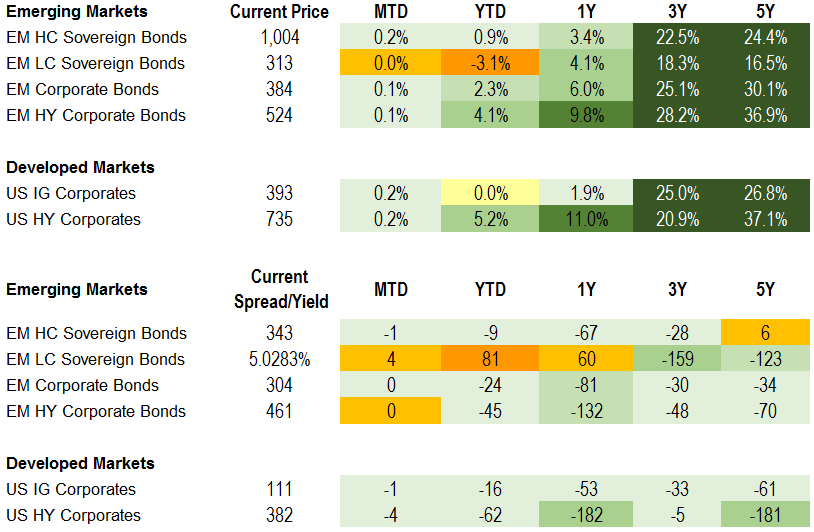
Equities
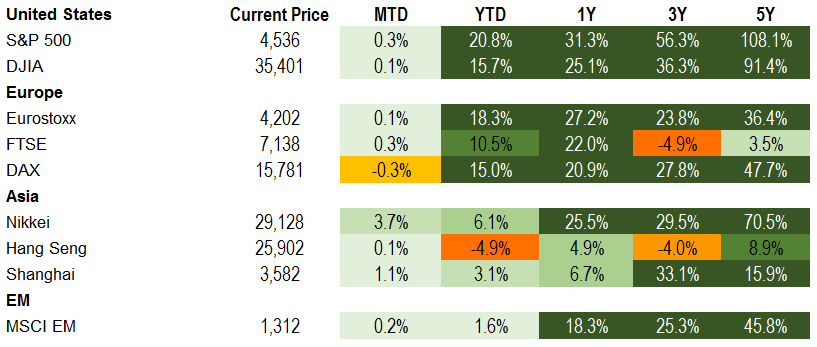
Commodities

Source for data tables: Bloomberg, JPMorgan, Gramercy. EM Fixed Income is represented by the following JPMorgan Indicies: EMBI Global, GBI-EM Global Diversified, CEMBI Broad Diversified and CEMBI Broad High Yield. DM Fixed Income is represented by the JPMorgan JULI Total Return Index and Domestic High Yield Index. Fixed Income, Equity and Commodity data is as of September 3, 2021 (mid-afternoon).
Emerging Markets Weekly Highlights
Brazil’s economic reform agenda slowly moves on, but faces significant obstacles as window of opportunity narrows ahead of 2022 elections
Event: Congress’ lower house approved the Bolsonaro Administration’s tax reform draft this week, but the proposal faces an uphill battle in the Senate. Meanwhile, the economy was flat (-0.1%) in quarter-on-quarter terms in 2Q, likely limiting full year 2021 GDP growth to around 5.0% year-on-year, lower than previously expected; water shortages are driving energy prices and the inflation outlook, higher.
Gramercy Commentary: After weathering a “perfect storm” of economic, public health and social pressures at the start of 2Q with relative success, the Bolsonaro Administration has now entered another difficult period that is likely to bring increased political noise and create higher uncertainty for markets. Significant headwinds for the government are materializing from slow progress and numerous setbacks to its reform agenda in Congress against a backdrop of accelerating inflation and GDP growth outlook being revised down, despite a significant improvement in COVID-19 vaccination rates during the third quarter. As a snippet of interesting local color, as recently as July the pandemic was still by far the main concern for Brazilians, according to polls (41%, followed by 12% for the economy/inflation). Now, with the advance of vaccinations, COVID-19 has dropped to 28%, while the economy and/or inflation jumped to 27%. These most recent dynamics underscore the challenging economic environment that the Bolsonaro Administration is facing as it positions itself for a vicious political fight against an invigorated former President Lula and the Left of Brazil’s political spectrum. Although it is still more than a year away from the October 2022 Presidential Elections, without the tailwind of the previously expected robust economic recovery supporting Bolsonaro’s re-election bid, it appears more likely that Lula might be the one enjoying a slight edge at the moment. From the perspective of Brazilian asset performance in late 2021 and into next year, we think that the pre-election dynamics between Lula and Bolsonaro are likely to be the main market driver. While we do not expect an imminent and/or abrupt loss of market confidence on Brazil, we think that, as we get closer to the elections, markets could get incrementally more concerned about a major structural policy shift in the event Lula solidifies his position as favorite and could start incorporating a more significant political risk premium into assets.
Record high approval ratings mark Guillermo Lasso’s first 100 days as Ecuador’s President
Event: According to pollster Cedatos, center-right Ecuadorian President Lasso’s approval ratings have continued to climb and stood at 74.1% at the end of August, marking Lasso’s first 100 days in office.
Gramercy Commentary: Lasso’s election as President back in April drove a powerful relief rally for the sovereign bond complex as investors re-assessed Ecuador’s economic reform outlook and prospects for IMF support under the former banker’s ambitious market-friendly agenda. However, lingering concerns about governability remained, given a fragmented National Assembly in which Lasso’s ability to deliver on his reform agenda depends on fragile alliances with populist-leaning parties. Despite this challenging political backdrop, we believe that thus far Lasso’s Administration has been able to outperform low initial expectations, largely propelled by the President’s strong approval ratings. The Ecuadorian public’s perception about Lasso has been boosted by a significant improvement in the COVID-19 pandemic management under his watch and strong progress on vaccination rates. High approval ratings have translated into better-than-expected political capital in Congress, despite some considerable noise and challenges that remain. This supports the government’s ability to deliver on IMF conditionality and underpins market confidence, and we believe further upside exists for the sovereign bonds if Lasso’s “honeymoon” with voters persists. The main downside risks relate to potential rifts within Lasso’s diverse and, to some extent, ad-hoc legislative coalition. Losing support from populist/left leaning forces, such as the indigenous movement Pachakutik, could complicate reform delivery under the IMF program and erode market confidence. However, Lasso’s high approval ratings are likely to continue to incentivize diverse political actors to cooperate with his administration’s agenda, in our view.
Emerging Markets Technicals
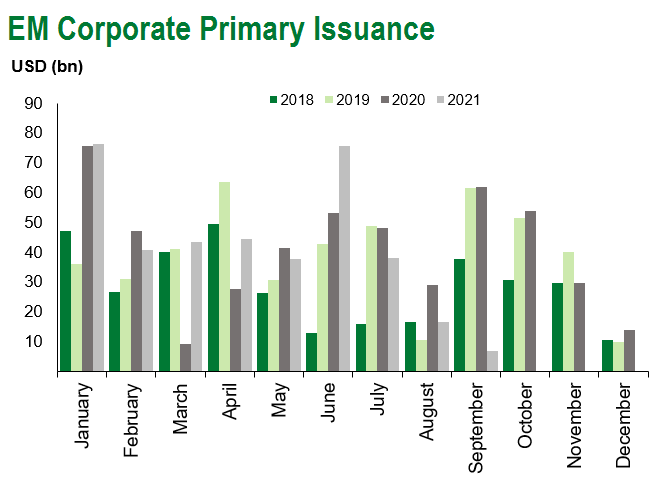
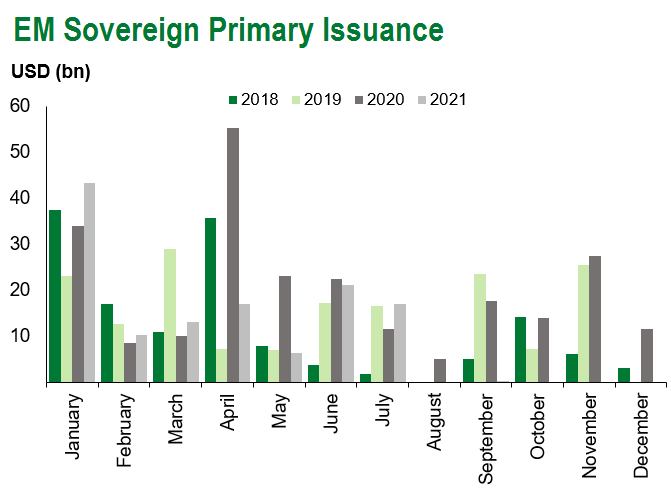
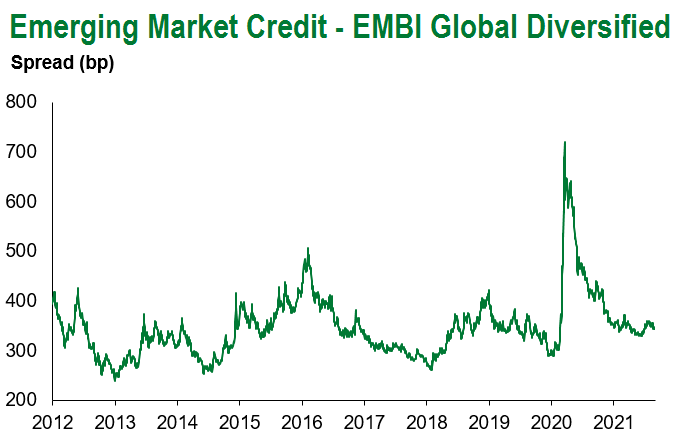
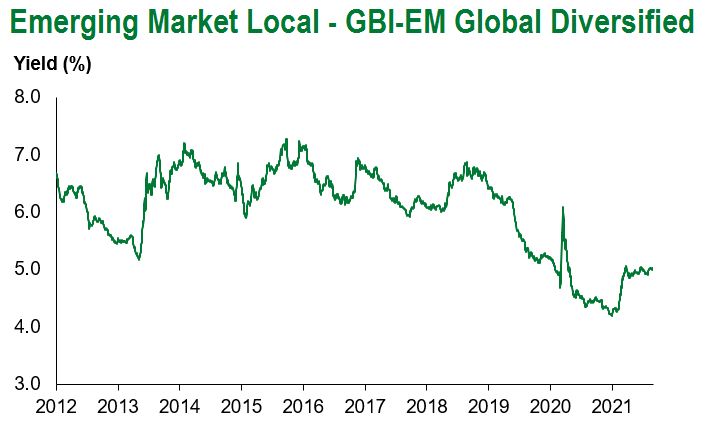
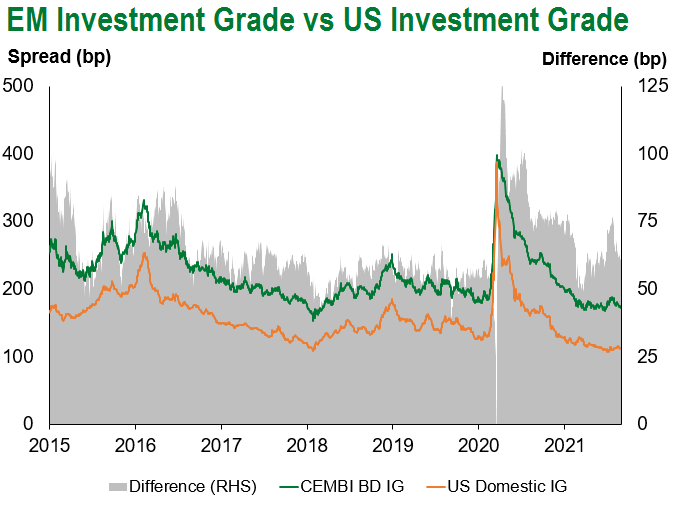
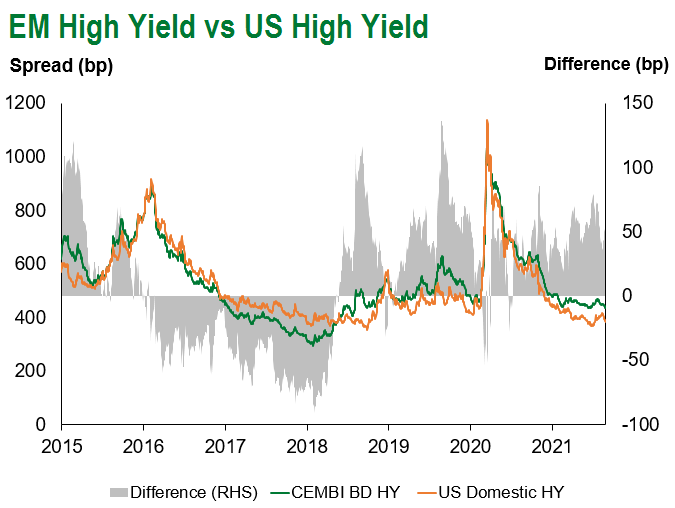
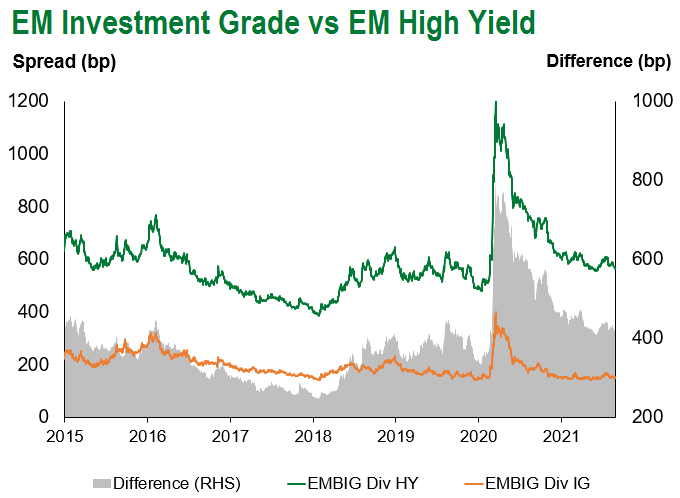
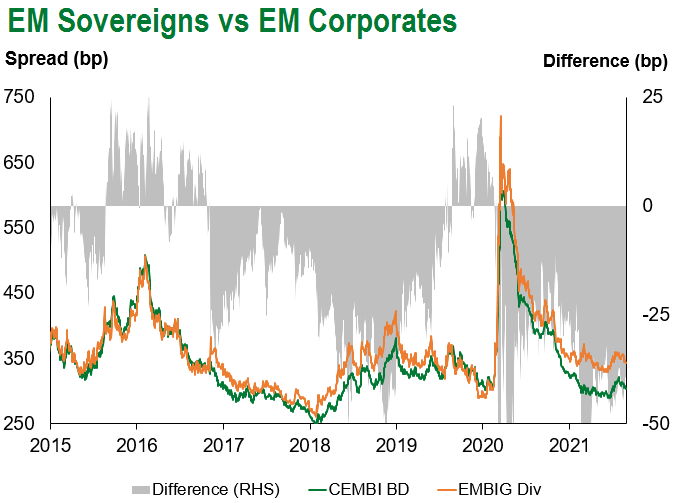
Emerging Markets Flows
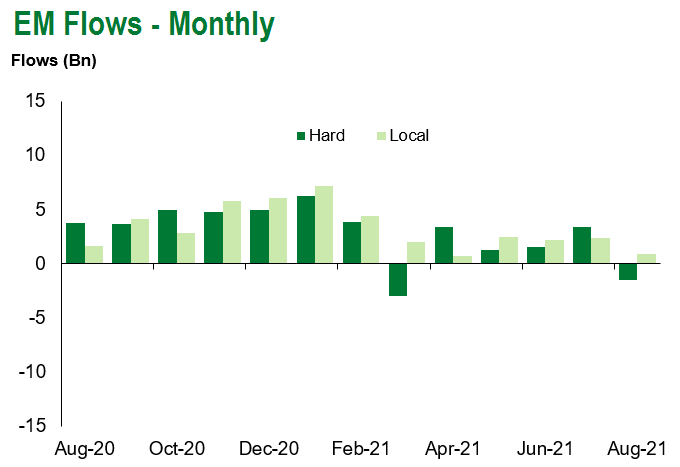
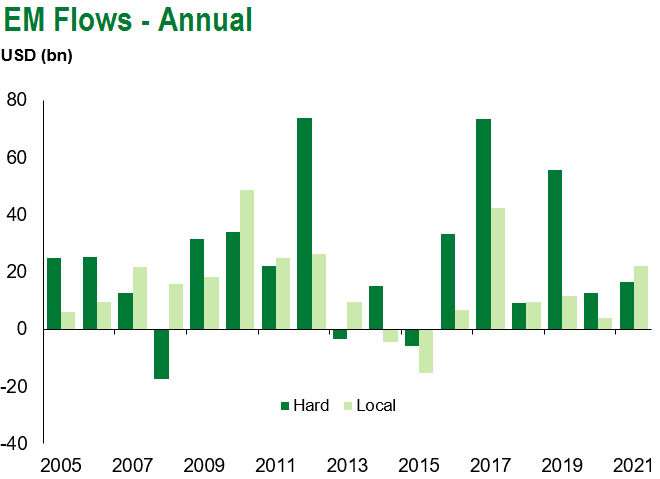
Source for graphs: Bloomberg, JPMorgan, Gramercy. As of September 3, 2021.
COVID Resources
Emerging Markets COVID-19 Case Summary
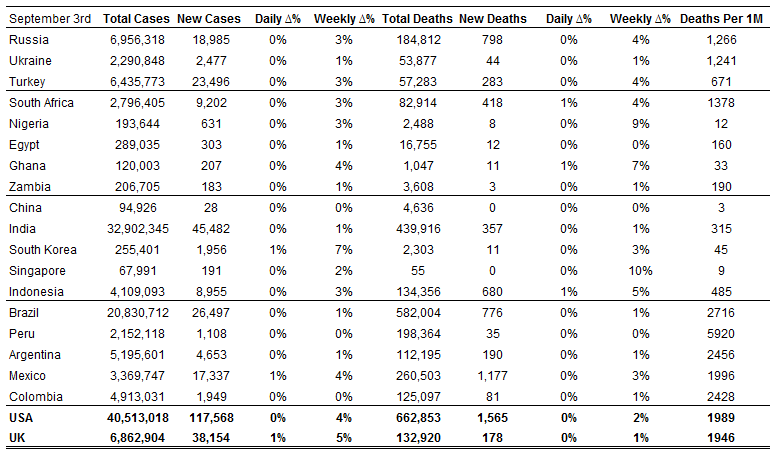
Source: Worldometer as of September 3, 2021.
Additional Crisis Resources:
Johns Hopkins COVID-19 Case Tracker
For questions, please contact:
Kathryn Exum, Senior Vice President, Sovereign Research Analyst, [email protected]
Petar Atanasov, Senior Vice President, Sovereign Research Analyst, [email protected]
Tolu Alamutu, CFA, Senior Vice President, Corporate Research Analyst, [email protected]
James Barry, Vice President, Corporate Research Analyst, [email protected]
This document is for informational purposes only. The information presented is not intended to be relied upon as a forecast, research or investment advice, and is not a recommendation, offer or solicitation to buy or sell any securities or to adopt any investment strategy. Gramercy may have current investment positions in the securities or sovereigns mentioned above. The information and opinions contained in this paper are as of the date of initial publication, derived from proprietary and nonproprietary sources deemed by Gramercy to be reliable, are not necessarily all-inclusive and are not guaranteed as to accuracy. This paper may contain “forward-looking” information that is not purely historical in nature. Such information may include, among other things, projections and forecasts. There is no guarantee that any forecasts made will come to pass. Reliance upon information in this paper is at the sole discretion of the reader. You should not rely on this presentation as the basis upon which to make an investment decision. Investment involves risk. There can be no assurance that investment objectives will be achieved. Investors must be prepared to bear the risk of a total loss of their investment. These risks are often heightened for investments in emerging/developing markets or smaller capital markets. International investing involves risks, including risks related to foreign currency, limited liquidity, less government regulation, and the possibility of substantial volatility due to adverse political, economic or other developments. The information provided herein is neither tax nor legal advice. Investors should speak to their tax professional for specific information regarding their tax situation.